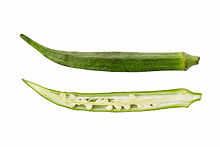Okra
| Okra | |
|---|---|

| |
| Mature and developing fruits (pods) (Hong Kong) | |

| |
| Longitudinal section of fruit | |
| Scientific classification | |
| Kingdom: | Plantae |
| Clade: | Tracheophytes |
| Clade: | Angiosperms |
| Clade: | Eudicots |
| Clade: | Rosids |
| Order: | Malvales |
| Family: | Malvaceae |
| Genus: | Abelmoschus |
| Species: | A. esculentus
|
| Binomial name | |
| Abelmoschus esculentus | |
| Synonyms[1] | |
| |
Okra (US: /ˈoʊkrə/, UK: /ˈɒkrə/), Abelmoschus esculentus, known in some English-speaking countries as lady's fingers,[2][3] is a flowering plant in the mallow family native to East Africa.[4] It has edible green seed pods. Cultivated in tropical, subtropical, and warm temperate regions around the world, okra is used in the cuisines of many countries.[5]
Etymology
Abelmoschus is
The first use of the word okra (alternatively; okro or ochro) appeared in 1679 in the
Origin and distribution

Okra is an
Okra originated in East Africa in

The plant was introduced to the Americas by ships plying the Atlantic slave trade[18] by 1658, when its presence was recorded in Brazil. It was further documented in Suriname in 1686. Okra may have been introduced to southeastern North America from Africa in the early 18th century. By 1748, it was being grown as far north as Philadelphia.[19] Thomas Jefferson noted it was well established in Virginia by 1781. It was commonplace throughout the Southern United States by 1800, and the first mention of different cultivars was in 1806.[4]
Botany and cultivation


The species is a
Abelmoschus esculentus is cultivated throughout the tropical and warm temperate regions of the world for its fibrous fruits or pods containing round, white seeds. It is among the most heat- and drought-tolerant vegetable species in the world and will tolerate soils with heavy clay and intermittent moisture, but frost can damage the pods. In cultivation, the seeds are soaked overnight prior to planting to a depth of 1–2 centimetres (3⁄8–13⁄16 in). It prefers a soil temperature of at least 20 °C (68 °F) for germination, which occurs between six days (soaked seeds) and three weeks. As a tropical plant, it also requires a lot of sunlight, and it should also be cultivated in soil that has a pH between 5.8 and 7, ideally on the acidic side.[20] Seedlings require ample water. The seed pods rapidly become fibrous and woody and, to be edible as a vegetable, must be harvested when immature, usually within a week after pollination.[21] The first harvest will typically be ready about 2 months after planting, and it will be approximately 2–3 inches (51–76 mm) long.[20]
The most common disease afflicting the okra plant is verticillium wilt, often causing a yellowing and wilting of the leaves. Other diseases include powdery mildew in dry tropical regions, leaf spots, yellow mosaic and root-knot nematodes. Resistance to yellow mosaic virus in A. esculentus was transferred through a cross with Abelmoschus manihot and resulted in a new variety called Parbhani kranti.[22]
In the United States much of the supply is grown in Florida, especially around
Production
In 2021, world production of okra was 10.8 million
as secondary producers.| Okra production – 2021 | |
|---|---|
| Country | (Millions of tonnes) |
| 6.47 | |
| 1.92 | |
| 0.67 | |
| 0.32 | |
| 0.26 | |
| World | 10.82 |
| Source: FAOSTAT[25] | |
Uses
Nutrition
Raw okra contains 90% water, 2%
(table).| Nutritional value per 100 g (3.5 oz) | |
|---|---|
| Energy | 138 kJ (33 kcal) |
7.46 g | |
| Sugars | 1.48 g |
| Dietary fibre | 3.3 g |
0.19 g | |
1.9 g | |
Niacin (B3) | 6% 1 mg |
| Folate (B9) | 15% 60 μg |
| Vitamin C | 26% 23 mg |
| Vitamin E | 2% 0.27 mg |
| Vitamin K | 26% 31.3 μg |
| Minerals | Quantity %DV† |
| Calcium | 6% 82 mg |
| Iron | 3% 0.62 mg |
| Magnesium | 14% 57 mg |
| Phosphorus | 5% 61 mg |
| Potassium | 10% 299 mg |
| Zinc | 5% 0.58 mg |
| Other constituents | Quantity |
| Water | 89.6 g |
| †Percentages estimated using US recommendations for adults,[26] except for potassium, which is estimated based on expert recommendation from the National Academies.[27] | |
Culinary
Okra is one of three
In South Asia, the pods are used in many spicy vegetable preparations as well as cooked with beef, mutton, lamb and chicken.[32][33]
Pods

The pods of the plant are
Leaves and seeds
Young okra leaves may be cooked similarly to the greens of
Greenish-yellow edible okra
Industrial
Bast fibre from the stem of the plant has industrial uses such as the reinforcement of polymer composites.[39] The mucilage produced by the okra plant can be used for the removal of turbidity from wastewater by virtue of its flocculant properties.[40][41] Having composition similar to a thick polysaccharide film, okra mucilage is under development as a biodegradable food packaging, as of 2018.[42] A 2009 study found okra oil suitable for use as a biofuel.[43]
Gallery
-
Large okra plants
-
A giant okra pod
-
Flower close-up
-
Stamen and pollen
-
Young seedling showingcotyledons
-
Fresh-picked fruits
-
Bhindi bharta, a South Asian dish
References
- ^ "The Plant List: A Working List of All Plant Species". Retrieved 3 October 2014.
- ^ "Okra". BBC Good Food. Retrieved 2023-04-12.
- ISBN 9780192803511. Retrieved 2023-04-12.
- ^ a b c d "Okra, or 'Gumbo,' from Africa". Texas AgriLife Extension Service, Texas A&M University. Archived from the original on March 4, 2005.
- ISBN 978-0-309-10333-6. Retrieved 2008-07-15.
- ^ "Definition of Abelmoschus". Merriam-Webster Dictionary. Retrieved 2020-06-23.
- ^ "Latin definition for esculentus, esculenta, esculentum (ID: 19365)". Latin Dictionary and Grammar Resources - Latdict. 2020. Retrieved 2020-06-23.
- ^ "Definition of okra". Merriam-Webster Dictionary. 2020. Retrieved 2020-06-23.
- ^ Justin Vogt (2009-12-29). "Gumbo: The mysterious history". The Atlantic. Retrieved 2020-06-23.
- ^ "Definition of gumbo". Merriam-Webster Dictionary. 2020. Retrieved 2020-06-23.
- ^ "Many food names in English come from Africa". VOA. 2018-02-06. Retrieved 2020-06-23.
- ^ Stanley Dry (2020). "A short history of gumbo". Southern Foodways Alliance. Retrieved 2020-06-23.
- ^ Patel, S. R. "GENETIC ADVANCE UNDER SELECTION IN SEGREGATING POPULATION IN OKRA (Abelmoschus esculentus L.)". AGRES – an International E. Journal.
- ISBN 9057821478.
- ^ Muimba-Kankolongo, Ambayeba (2018). "Okra: Vegetable Production - Origin and Geographic Distribution". Science Direct.
- ISBN 978-0-7591-0466-2.
- ^ "Okra - an overview | ScienceDirect Topics". www.sciencedirect.com. Retrieved 2021-11-09.
- ^ "Okra, Gumbo, & Rice". unesdoc.unesco.org.
- ^ "Colonial Food In Philadelphia - 1883 Words | Internet Public Library". www.ipl.org. Retrieved 2021-11-09.
- ^ a b Almanac, Old Farmer's. "Okra". Old Farmer's Almanac. Retrieved 2021-04-29.
- ^ Kurt Nolte. "Okra seed" (PDF). Yuma County Cooperative Extension. Archived from the original (PDF) on 2014-10-31. Retrieved 2012-10-17.
- ^ Plant breeding, Chapter 9.2 (PDF). Strategies For Enhancement in Food Production. 2020.
- ^ Regional Integrated Pest Management CentersDatabase. 2022-05-04. Retrieved 2022-06-30.
- ISBN 978-1-60107-002-9. 7210.
- Food and Agriculture Organization, Statistics Division. 2021. Retrieved 19 February 2023.
- ^ United States Food and Drug Administration (2024). "Daily Value on the Nutrition and Supplement Facts Labels". Retrieved 2024-03-28.
- )
- ISBN 978-0-87805-563-0.
- ^ Julie Schwietert Collazo. "Cuban Quimbombo (Afro-Cuban Okra)". The Latin Kitchen. Archived from the original on 2020-10-23. Retrieved 2020-10-21.
- ^ Gloria Cabada-Leman (22 June 2008). "QUIMBOMBÓ GUISADO". whats4eats. Retrieved 2020-10-21.
- ^ "El intrépido molondrón" (in Spanish). Diario Libre. Retrieved 2022-08-29.
- ISBN 978-1-4696-1442-7. Retrieved 22 December 2021.
- ISBN 0-313-32487-5. Retrieved 22 December 2021.
- ^ PMID 27004112.
- ^ Jill Neimark (5 September 2018). "Leave it to botanists to turn cooking into a science lesson". US National Public Radio. Retrieved 26 June 2020.
- ^ Austin State Gazette [TEX.], November 9, 1861, p. 4, c. 2, copied in Confederate Coffee Substitutes: Articles from Civil War Newspapers Archived September 28, 2007, at the Wayback Machine, University of Texas at Tyler
- S2CID 38546395.
- ^ Mays, D A, Buchanan, W, Bradford, B N, Giordano, P M (1990). "Fuel production potential of several agricultural crops". Advances in New Crops: 260–263.
- .
- S2CID 139366820.
- .







